The NVIDIA GeForce GTX 1660 Super Review, Feat. EVGA SC Ultra: Recalibrating The Mainstream Market
by Ryan Smith on October 29, 2019 9:00 AM ESTPower, Temperatures, & Noise
Last, but not least of course, is our look at power, temperatures, and noise levels. While a high performing card is good in its own right, an excellent card can deliver great performance while also keeping power consumption and the resulting noise levels in check.
| NVIDIA GeForce Video Card Voltages | ||
| Model | Boost | Idle |
| EVGA GTX 1660 Super Ultra SC | 1.05v | 0.618v |
| GeForce GTX 1660 | 1.043v | 0.656v |
| GeForce GTX 1660 Ti | 1.005v | 0.65v |
Using the same TU116 GPU as the GTX 1660 Ti and the GTX 1660 (vanilla0, the voltages are unsurprisingly similar. 1.05v is essentially a universal limit for NVIDIA Turing GPUs at stock, while the idle voltage of 0.618v is a bit lower than what we’ve seen on other TU116 cards thus far.
| GeForce Video Card Average Clockspeeds | |||||
| Game | GTX 1660 Super (Ref Clocks) |
EVGA GTX 1660 Super SC Ultra |
GTX 1660 Ti | GTX 1660 | |
| Max Boost Clock | 1935MHz | 1980MHz | 1950MHz | 1935MHz | |
| Boost Clock | 1785MHz | 1830MHz | 1680MHz | 1785MHz | |
| Shadow of the Tomb Raider | 1860MHz | 1905MHz | 1875MHz | 1875MHz | |
| F1 2019 | 1860MHz | 1905MHz | 1890MHz | 1875MHz | |
| Assassion's Creed: Odyssey | 1875MHz | 1920MHz | 1905MHz | 1890MHz | |
| Metro: Exodus | 1860MHz | 1905MHz | 1890MHz | 1875MHz | |
| Strange Brigade | 1860MHz | 1905MHz | 1890MHz | 1890MHz | |
| Total War: Three Kingdoms | 1860MHz | 1890MHz | 1890MHz | 1875MHz | |
| The Division 2 | 1845MHz | 1875MHz | 1875MHz | 1860MHz | |
| Grand Theft Auto V | 1875MHz | 1920MHz | 1905MHz | 1890MHz | |
| Forza Horizon 4 | 1875MHz | 1905MHz | 1905MHz | 1890MHz | |
The situation with clockspeeds is also very similar, though not entirely a carbon copy of the GTX 1660 (vanilla). Even with NVIDIA’s slightly higher TDP, our GTX 1660 Super card sees a very slight drop in clockspeeds, typically coming in one bin (15MHz, or under-1%) below the original card. In this case it’s a tradeoff we’re glad to take, since as we’ve just seen, the extra memory bandwidth on the GTX 1660 Super more than makes up for any clockspeed deficit, launching the Super card well ahead of its GDDR5-based predecessor.
In any case, the GTX 1660 Super once again comes in well ahead of NVIDIA’s official boost clock specifications. Even under The Division 2, average clockspeeds beat the spec by 60MHz, and in other games It’s more frequently 75 to 90MHz above.
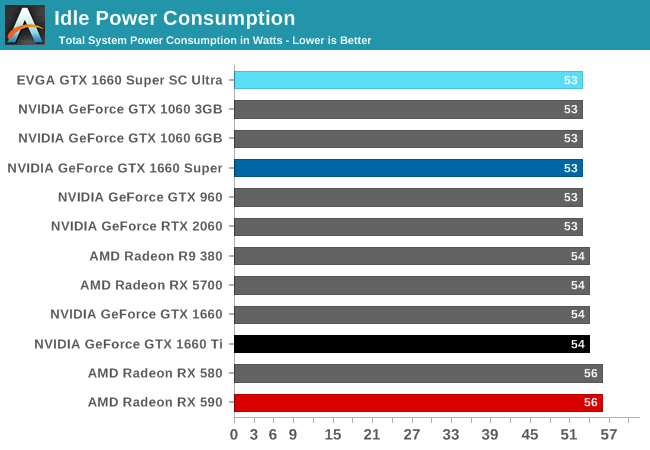
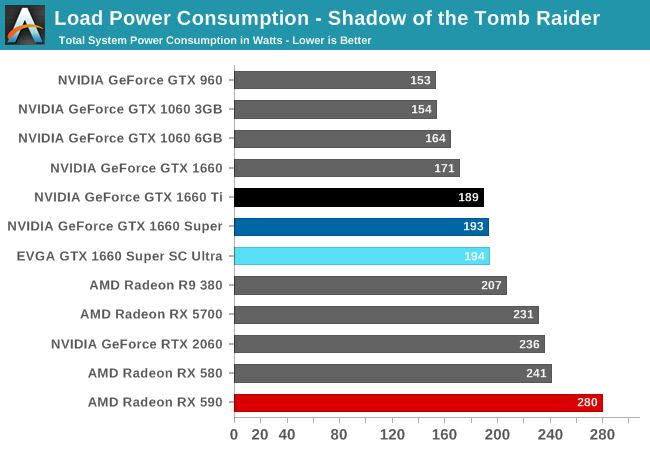
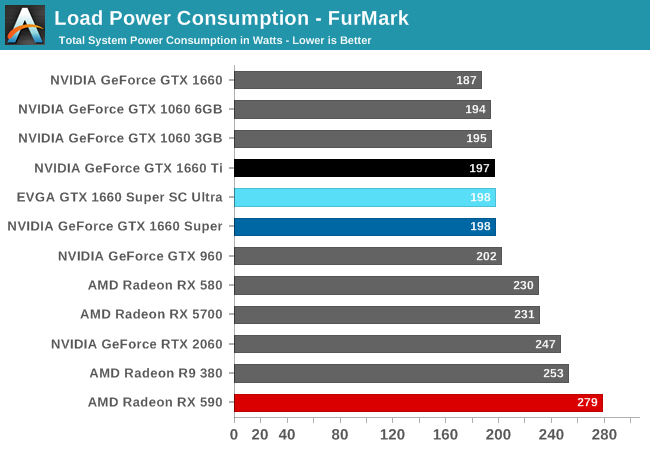
Shifting to power consumption, our results are in line with NVIDIA’s specifications, as well as what we’d expect for yet another TU116 card. With its 125W TGP, the GTX 1660 Super draws ever so slightly more power than either the GTX 1660 Ti or the GTX 1660, particularly in Tomb Raider where the CPU gets a bit more of a workout as well. But on the whole, it’s right in the ballpark with other 120W(ish) NVIDIA cards, with power consumption at the wall for the entire testbed not exceeding 200W.
For the midrange segment, the GTX 1660 Super (and the GTX 1660 Ti) are the cards to beat when it comes to power consumption and efficiency. Everything else at this power level performs much slower, or it’s faster while requiring more power. Though faster cards aren’t too far off, as the RX 5700 can attest to.
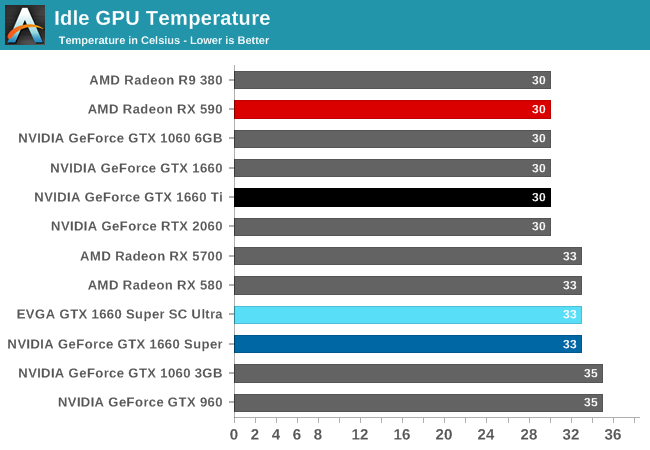


As for temperatures, EVGA has delivered one cool running card. Even at its full, factory overclocked speeds, the EVGA GTX 1660 Super SC Ultra never cracks 70C, and under FurMark’s pathological workload it’s the second-quietest card in these cards.
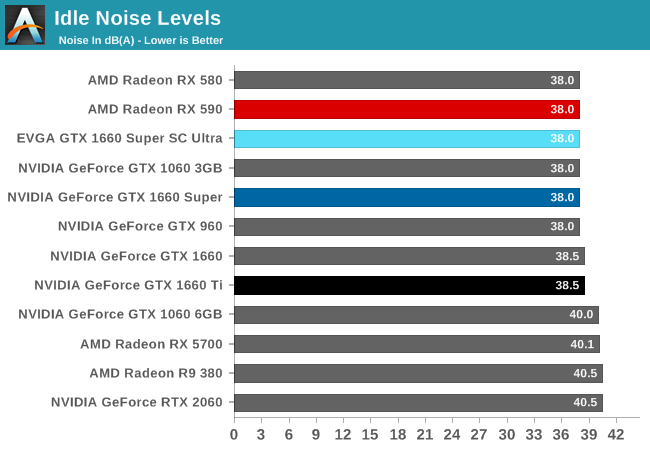

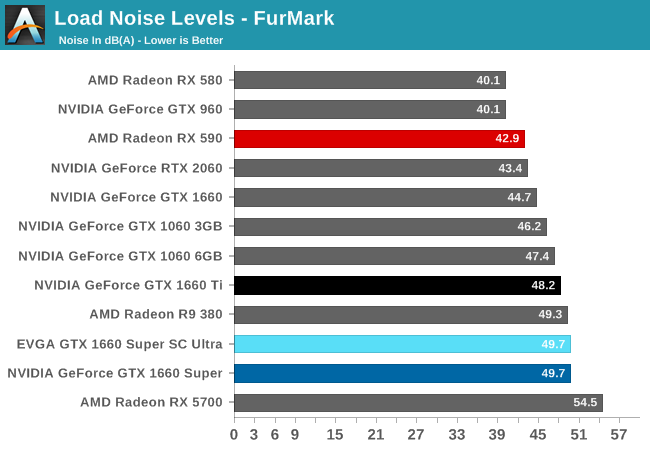
The tradeoff for those temperatures, however, is noise. The EVGA card that delivers chart-topping temperatures also delivers some of the worst noise results among this collection of cards.
The culprit here would seem to be EVGA’s decision to bias the card towards cooling performance rather than acoustics. Which given how far the card is from its 83C thermal throttle point, seems overdone. EVGA could easily back off on the fan speed a bit, let the temperatures drift up to the low 70s, and deliver essentially the same gaming performance (perhaps losing 1 bin in the process) while generating a lot less noise. We have a number of 120W open air cards in these cards, including the GTX 1660 3GB and GTX 960, both of which move just as much heat with much less noise, so it can be done. And, to be fair to EVGA here, their SC Ultra card is by no means a tornado, barely hitting 50 dB(A) in these intensive, open case tests, but the best cards strike a proper balance between noise and performance, maximizing the latter while minimizing the former.
Ultimately, I suspect part of the engineering challenge EVGA is dealing with here is that the SC Ultra cooler is their smallest GTX 1660 cooler. The triple-slot XC cards (represented here with the GTX 1660 Ti and GTX 1660) have just one fan and much bigger heatsinks to work with. Similarly, EVGA also sells longer dual-slot cards (also called XC) which get the benefit of a longer heatsink. The physics of more heatsink mass (and more/bigger fins) can’t be ignored, which is why smaller cards often need to run faster fans. Still, even if the SC Ultra cooler isn’t particularly big, I do think there’s room for a better fan balance here.
Tangentially, as I mentioned in the EVGA SC Ultra overview, this is actually our second card. The original was even hotter and louder; it reached 75C and 54.6 dB(A) under Tomb Raider in that test. Considering that these GTX 1660 Super cards are operating near or at their power limits and are TDP-capped by the VRMs and monitoring hardware – and thus, one card can’t draw significantly more power than another identical card – it points to a cooling problem with the card itself. EVGA has since taken the card back to figure out what’s going on, but I suspect what they’ll find is poor thermal transfer between the GPU and heatsink, perhaps due to a bad TIM application or a problem with the heatpipes. Ultimately it’s rare that we get dud video cards, but it does happen now and then.


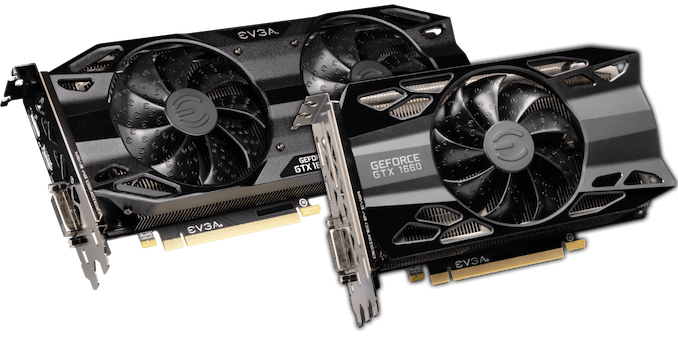








65 Comments
View All Comments
flyingpants265 - Monday, November 4, 2019 - link
It's ridiculous because I've been hearing about 4k for so long, and most of us are STILL gaming at 1080p. A 1080p card still costs $229 when most of us have them already. I am not willing to sink that amount of money into something that is already obsolete.RX570, RX580, and GTX1060 are cheap and plentiful on the used market for $65-120.
DanNeely - Tuesday, October 29, 2019 - link
"Truthfully, I’m not even sure NVIDIA’s GPU binning operations changed for this product, or if they just had partners slap TU116-300 GPUs on a PCB wired for GDDR6."I'd assume a bit of tweaking around the edges because of the different memory controllers. Base 1660's can use a chip with a dud GDDR6 controller, 1660S needs that but can tolerate a dud GDDR5 one.
AshlayW - Tuesday, October 29, 2019 - link
I'm fairly certain the memory controller supports both GDDR6 and GDDR5 concurrentlyDanNeely - Tuesday, October 29, 2019 - link
Different IO pinouts seems to require at least some parts to be different.DominionSeraph - Tuesday, October 29, 2019 - link
>Instead, this is a pure virtual launch, with all of the cards on the market being partner designs.Anandtech: where a hard launch is called a paper launch because the chip manufacturer only handed out a paper saying it was now ok to pair the TU116-300 that has been selling for months with GDDR6 instead of making a reference board which nobody needed.
Ryan Smith - Tuesday, October 29, 2019 - link
To be sure, virtual does not mean paper in this context. It's actually NVIDIA's official term for a video card launch where they don't make any retail cards of their own. It's not derogatory in any way.yeeeeman - Tuesday, October 29, 2019 - link
The title of this article should be "Nvidia preparing for Radeon RX5500".Xeres14 - Tuesday, October 29, 2019 - link
Not bad. Good for a specific budget but it seems the extra $ for the 2060 is worth it.Showtime - Tuesday, October 29, 2019 - link
If you're talking bang for the buck, the 2060 is bad. Bang for buck cards would probably be RX570/580 on sale regularly, this new card, then AMD 5700, then 5700x, then the $500 2070 super. The rest of the lineup is terrible performance for the dollar. Used cards are relative bargains. 8GB AMD RX cards are under $100, and used 10 series cards finally dropping again. $400 1080 ti's, and sub $300 1080/1070 ti's are tough to beat.Shlong - Tuesday, October 29, 2019 - link
I replaced a GTX 960 4GB in one of my old systems (6 core 4930k @ 4.5) with a $210 1070 TI 8GB from ebay and my old laptop with an Acer Predator Helios 300 (6 core 9750H paired with 1660Ti 6GB) which I picked up for under $1000 during the Prime deal. What a night and day difference!